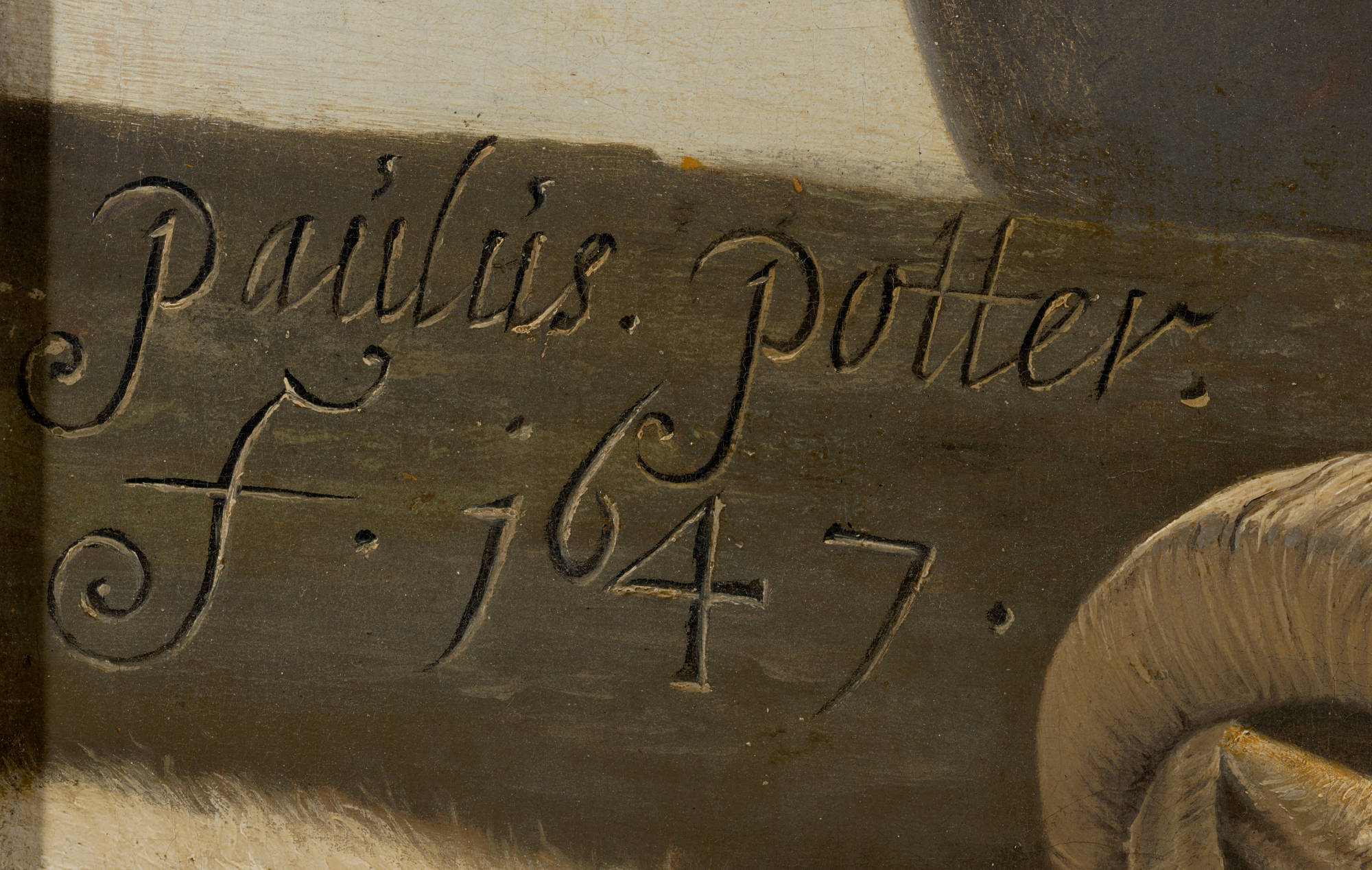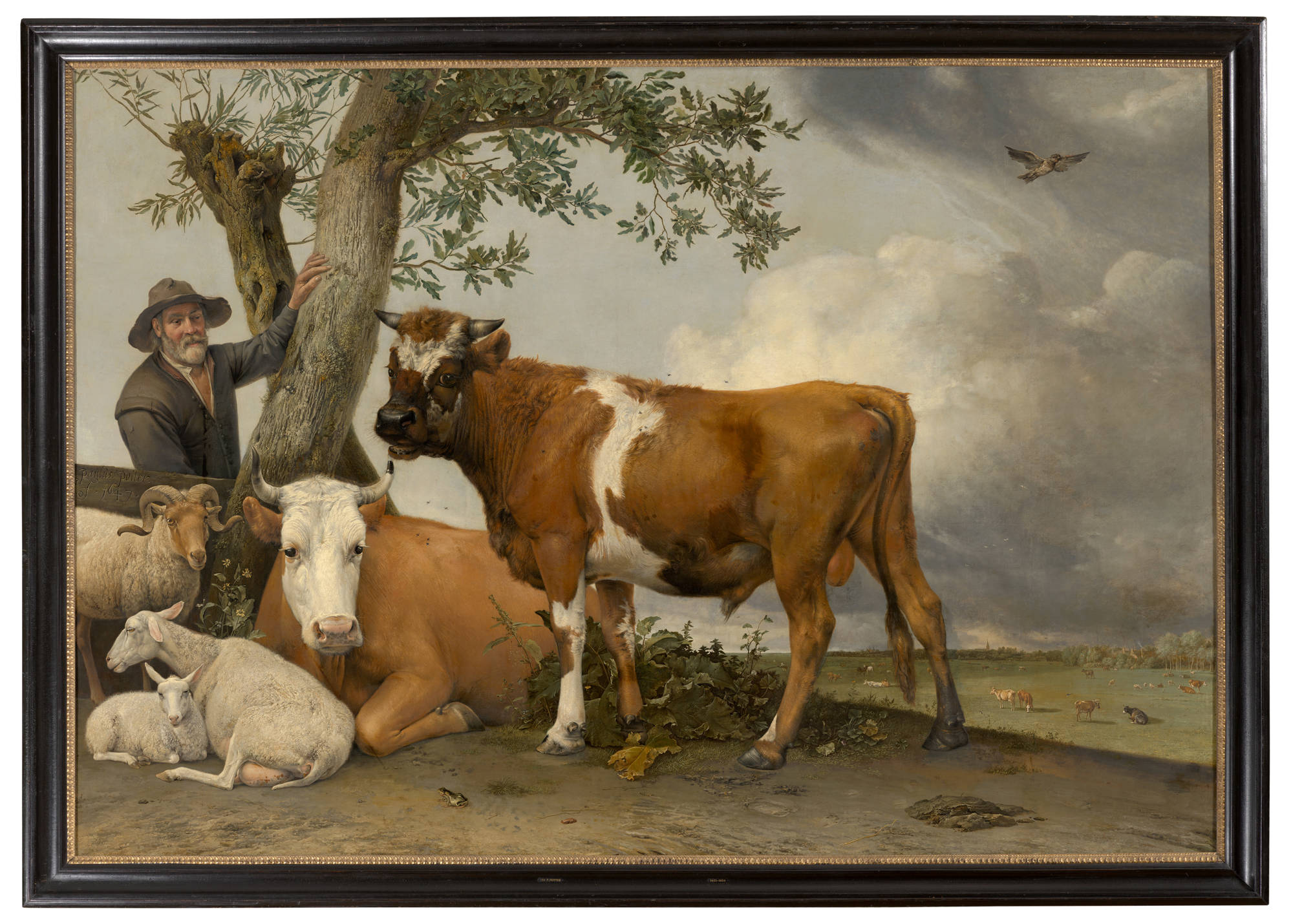Nowadays, most of the visitors to the Mauritshuis come mainly to see the paintings by Rembrandt, Johannes Vermeer, Jan Steen and Frans Hals. At the beginning of the nineteenth century, it was the fame of ‘Potter’s bull’ that attracted visitors from far and wide. The combination of the unpretentious subject, the life-sized format, and the painting’s astonishing realism - from the flies on the bull’s coat to the cow’s damp nose - made this work the epitome of Dutch painting.
The bull gazes at us, as do the cow lying on the ground and the standing ram, a Drenthe vossenkop moorland sheep. The sheep lying with its lamb is a milking sheep, which is recognisable by its smooth, hairless tail. Potter has rendered the animals’ coats with meticulous care. In the sheep lying down, we can even make out the marks left by the scissors in the newly sheared fleece. The skin of the bull’s head is elaborated in minute detail, in thickly applied layers of paint. The farmer will seem familiar to many Dutch viewers, since he was taken as the model for the character ‘Teun’ in children’s first readers. Above the trees on the horizon we can make out the silhouette of the church of Rijswijk, a village between The Hague and Delft.
Until a few years ago it was generally believed that Potter had painted an existing bull. The discrepancies between the different parts of the animal’s body make this impossible, however. The drooping dewlap and the horns are indicative of an age of two years. But the animal’s six large permanent teeth point to a bull aged three or four. The forequarters are well-developed while the hindquarters are rather smooth. What is more, the perspective is wrong. The forequarters and hindquarters are shown at an angle to the picture plane, while the animal’s torso is parallel to it. The only possible conclusion is that Potter composed his bull from a variety of preliminary studies of different animals.
We can imagine the artist walking around Holland’s moorland areas in the vicinity of The Hague or Delft, making sketches of the cattle he saw in and around the farms there. The artists’ biographer Arnold Houbraken reports in his Groote Schouburgh der Nederlantsche Konstenaars en Konstenaressen (1718-1721) that Potter’s widow ‘never saw her husband idle; that when he had an hour to spend with her, to go for a walk outside, he always took a sketchbook with him so that if he saw anything which was interesting and which might come in useful, he would make a sketch of it’.
Technical investigation has shown that The Bull was not initially designed with its current large size. Seams in the canvas that are still visible today indicate that Potter’s first plan was to paint only the bull. Later on he attached strips of linen measuring 40 to 60 cm in width to the two sides and upper edge, on which he added the other animals, the farmer, and the landscape. We can only hazard a guess as to the reason for this enlargement. By turning it into a cattle piece with more staffage, he certainly made his painting more interesting for the market.
Most of Potter’s oeuvre consists of small cabinet pieces with scenes of peasant life. He produced only a handful of larger works. It is a mystery what Potter had in mind when he made this monumental Bull. One of the most plausible explanations is that he wanted to emulate famous painters from classical antiquity. Karel van Mander’s much-read treatise on painting, Den grondt der edel vry schilder-const, cites the story of the Greek painter Pausias, who painted a deceptively real ox that looked the viewer straight in the eye while its body was viewed from the side.
In 1795 French troops seized The Bull along with 200-odd other works from the collection of William V in the stadholder’s gallery at Buitenhof in The Hague and took it to Paris. The painting made a deep impression on viewers in the Louvre, then the Musée Napoléon, where it hung among the paintings by Raphael and Titian that Napoleon had seized from Italy. Even then it was precisely the work’s uncompromising realism that people so admired. The first director of the Mauritshuis, jonkheer Steengracht van Oostkapelle, wrote in the 1826 catalogue: ‘The imitation of nature cannot be honed to any higher degree of perfection than in this marvellous piece’.
(this is a reworked version of a text published in in: P. van der Ploeg, Q. Buvelot, Royal Picture Gallery Mauritshuis: A princely collection, The Hague 2005)







